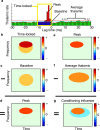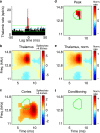Feature selectivity and interneuronal cooperation in the thalamocortical system
- PMID: 11588186
- PMCID: PMC6763836
- DOI: 10.1523/JNEUROSCI.21-20-08136.2001
Feature selectivity and interneuronal cooperation in the thalamocortical system
Abstract
Action potentials are a universal currency for fast information transfer in the nervous system, yet few studies address how some spikes carry more information than others. We focused on the transformation of sensory representations in the lemniscal (high-fidelity) auditory thalamocortical network. While stimulating with a complex sound, we recorded simultaneously from functionally connected cell pairs in the ventral medial geniculate body and primary auditory cortex. Thalamic action potentials that immediately preceded or potentially caused a cortical spike were more selective than the average thalamic spike for spectrotemporal stimulus features. This net improvement of thalamic signaling indicates that for some thalamic cells, spikes are not propagated through cortex independently but interact with other inputs onto the same target cell. We then developed a method to identify the spectrotemporal nature of these interactions and found that they could be cooperative or antagonistic to the average receptive field of the thalamic cell. The degree of cooperativity with the thalamic cell determined the increase in feature selectivity for potentially causal thalamic spikes. We therefore show how some thalamic spikes carry more receptive field information than average and how other inputs cooperate to constrain the information communicated through a cortical cell.
Figures






Similar articles
-
Slow oscillation in non-lemniscal auditory thalamus.J Neurosci. 2003 Sep 10;23(23):8281-90. doi: 10.1523/JNEUROSCI.23-23-08281.2003. J Neurosci. 2003. PMID: 12967990 Free PMC article.
-
Functional convergence of response properties in the auditory thalamocortical system.Neuron. 2001 Oct 11;32(1):151-60. doi: 10.1016/s0896-6273(01)00445-7. Neuron. 2001. PMID: 11604146
-
Spectrotemporal receptive fields in the lemniscal auditory thalamus and cortex.J Neurophysiol. 2002 Jan;87(1):516-27. doi: 10.1152/jn.00395.2001. J Neurophysiol. 2002. PMID: 11784767
-
Corticofugal modulation of the auditory thalamus.Exp Brain Res. 2003 Dec;153(4):579-90. doi: 10.1007/s00221-003-1680-5. Epub 2003 Oct 22. Exp Brain Res. 2003. PMID: 14574430 Review.
-
Functional organization of lemniscal and nonlemniscal auditory thalamus.Exp Brain Res. 2003 Dec;153(4):543-9. doi: 10.1007/s00221-003-1611-5. Epub 2003 Aug 23. Exp Brain Res. 2003. PMID: 12937877 Review.
Cited by
-
A theory of cortical map formation in the visual brain.Nat Commun. 2022 Apr 28;13(1):2303. doi: 10.1038/s41467-022-29433-y. Nat Commun. 2022. PMID: 35484133 Free PMC article.
-
Three groups of interneurons account for nearly 100% of neocortical GABAergic neurons.Dev Neurobiol. 2011 Jan 1;71(1):45-61. doi: 10.1002/dneu.20853. Dev Neurobiol. 2011. PMID: 21154909 Free PMC article. Review.
-
Defining cortical frequency tuning with recurrent excitatory circuitry.Nat Neurosci. 2007 Dec;10(12):1594-600. doi: 10.1038/nn2012. Epub 2007 Nov 11. Nat Neurosci. 2007. PMID: 17994013 Free PMC article.
-
Spectral integration in primary auditory cortex attributable to temporally precise convergence of thalamocortical and intracortical input.J Neurosci. 2010 Aug 18;30(33):11114-27. doi: 10.1523/JNEUROSCI.0689-10.2010. J Neurosci. 2010. PMID: 20720119 Free PMC article.
-
Synchrony, connectivity, and functional similarity in auditory midbrain local circuits.Neuroscience. 2016 Oct 29;335:30-53. doi: 10.1016/j.neuroscience.2016.08.024. Epub 2016 Aug 17. Neuroscience. 2016. PMID: 27544405 Free PMC article.
References
-
- Aertsen AMHJ, Johannesma PIM. Spectro-temporal receptive fields of auditory neurons in the grassfrog. Biol Cybern. 1980;38:223–234. - PubMed
-
- Alonso JM, Usrey WM, Reid RC. Precisely correlated firing in cells of the lateral geniculate nucleus. Nature. 1996;383:815–819. - PubMed
-
- Cotillon N, Nafati M, Edeline JM. Characteristics of reliable tone-evoked oscillations in the rat thalamo-cortical auditory system. Hear Res. 2000;142:113–130. - PubMed
-
- Creutzfeldt O, Hellweg FC, Schreiner CE. Thalamocortical transformation of responses to complex auditory stimuli. Exp Brain Res. 1980;39:87–104. - PubMed
-
- Dan Y, Alonso JM, Usrey WM, Reid RC. Coding of visual information by precisely correlated spikes in the lateral geniculate nucleus. Nat Neurosci. 1998;1:501–507. - PubMed
Publication types
MeSH terms
Grants and funding
LinkOut - more resources
Full Text Sources
Other Literature Sources
